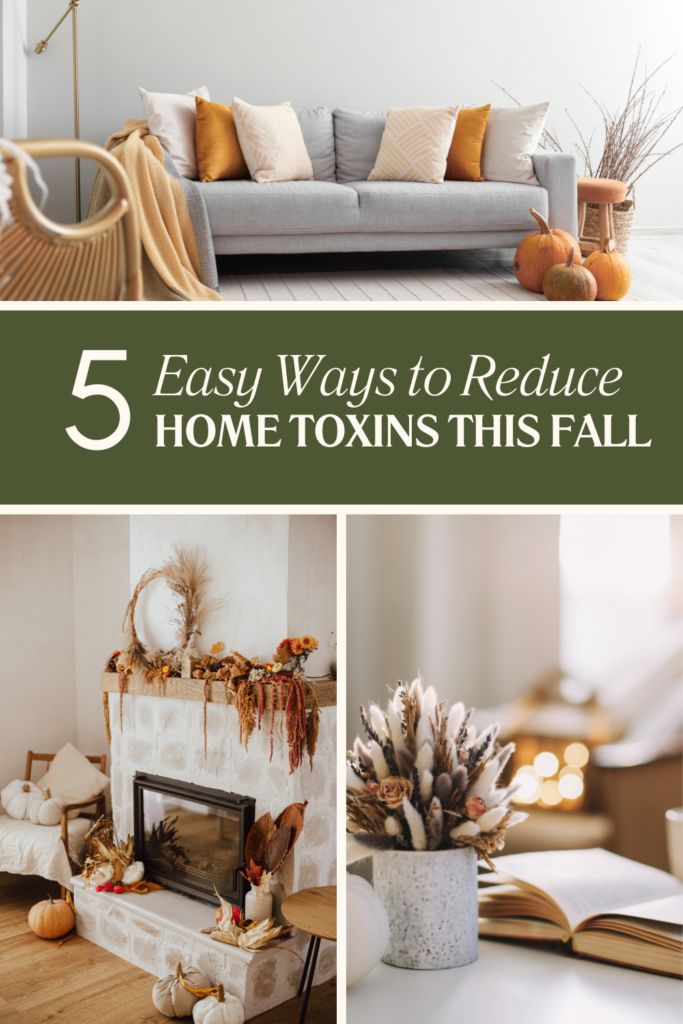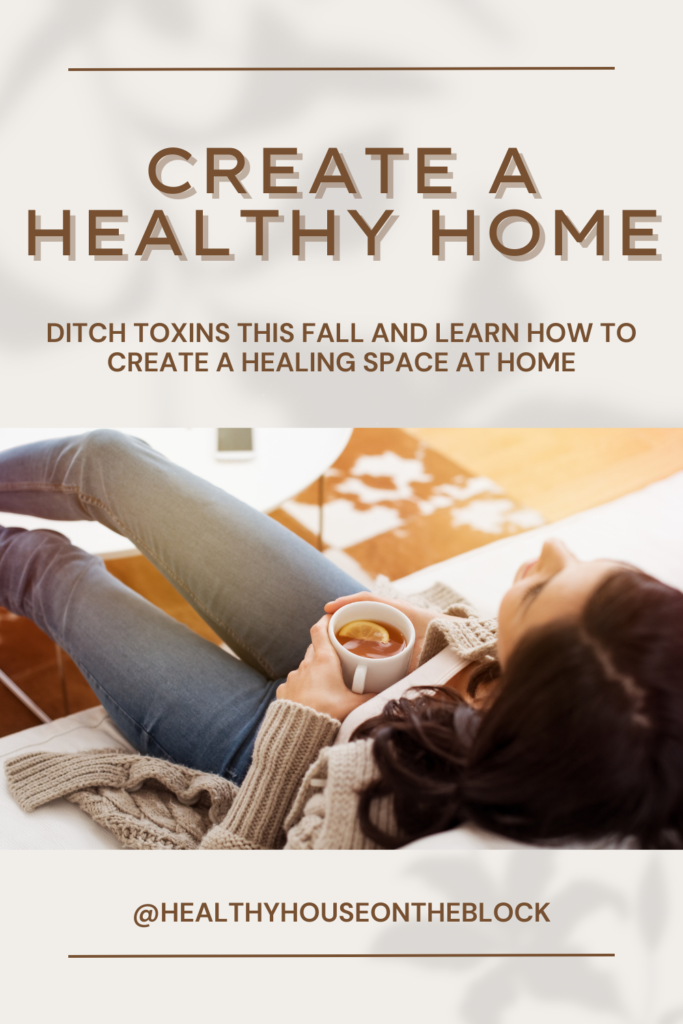
Sometimes fall can feel like just the reset that we need. But it can also be a reset for your house too. I like to use each season as a reminder to get my house back in order, reduce toxins that I may have allowed in over the last season and create a space that can ultimately heal my body. These fall ideas will help you achieve that reset that you need in your home.
Every time the seasons change, use it as a reminder that your home and your body need a slight detox to get everything running back down to the basics. It’s a time where I love to simplify what we have and reduce the items we use on a daily basis too. The truth is the fewer items and products you have in your home, the fewer toxins you’re bringing inside too.
Let’s walk through some basic fall ideas to help you create a healing environment in your home. Afterall, a home should be a place where our bodies can heal and flourish. So many homes are actually burdening down the health and wellness of the families that live there. And once your body can’t detoxify toxins fast enough, you can start to see illness creep in, taking on many forms.
My goal is to help you create a healthier space to prevent this from ever happening in your body or home. It’s so true that the health of your environment will directly impact the health of your body.
FALL IDEAS THAT ARE TOXIN FREE FOR YOUR HOME
My kids love when we start decorating for fall. Over the years I’ve collected fall ideas that I reuse every year as well as some low toxin items that we use to decorate our home. I’m big on bringing nature indoors for this time of year because the nature is just SO. DARN. BEAUTIFUL.
Bring in Nature:
- Pumpkins & Gourds: These are biodegradable, naturally festive, and can be composted after the season.
- Dried Flowers & Grasses: Consider using dried wheat, lavender, or eucalyptus for wreaths or table centerpieces.
- Pinecones, Acorns, & Branches: Collect these from your yard or a nature walk. They’re perfect for creating seasonal decor that can be reused year after year.
Avoid Plastic: Instead use ceramic, baskets or other natural materials that won’t bring microplastic toxins, phthalates and other harmful chemicals into your space.
Use Eco-Friendly Fabric and Natural Fibers:
- Opt for organic cotton or linen throw blankets and pillows in warm fall hues like burnt orange, mustard, or burgundy.
- You can also look for pillow covers made from natural, toxin-free dyes.

BE CAUTIOUS OF FALL SCENTS
One fall idea to be VERY wary of this autumn is that SO many normal items have scents added to them. And chances are they really aren’t natural scents. From candles to things like pillows, they all seem to have that warm cinnamon scent. I would be extra cautious about decor that you purchase, because to be honest, they aren’t going to disclose what they use to make their product smell so “good”, right?
I would avoid candles, plug-ins, sprays and wax melts all together if possible. And just know that you’ll probably be walking into lots of homes and buildings that may have these types of scented items around. This is why it’s a great time to make sure your house is clear of them — which allows your body more time to naturally detoxify.
INCREASE VENTILATION
Depending on your location, opening windows and increasing ventilation in your space can be a great way to detox your house a bit before winter.
The simple act of opening the windows in your home will allow two things to happen. First, it allows toxins to disperse outside rather than inside. Some of the toxins will still end up in the house, but allowing some to flow outside is beneficial. The second thing that will happen is that the indoor air will become diluted with fresh outdoor air.
Opening windows, even if for a small stretch of time, is extremely beneficial to the health of our air at home. And fall is a great time to do that as there is less humidity in the air and generally the temperatures are cool but not frigid.
In addition to opening the windows, you can also run your whole house fan connected to your furnace or air conditioner. When the heat or cooling system is on, it moves hot or cold air around. However, in the fall, it’s a great time to turn off the furnace or air at your thermostat and simply use the fan option.
This will help keep air moving and flowing without adding a lot to your energy consumption or bills.
By circulating air through your house you allow the opportunity for the air pressure in the house to lower, which means your home won’t pull in toxins from underneath the foundation. If you live in an area where Radon is prevalent, this is a great precaution to take.
Moving air around your house will also help in terms of displacing concentrated levels of toxins. When pairing the whole house fan with open windows or running vented fans, you’ll displace the toxins in your home outdoors.

MONITOR HUMIDITY LEVELS
If you do choose to open your windows, take extra care to keep an eye on your indoor humidity levels. You’ll want to keep them between 35% – 40%. By keeping your indoor climate in this range you can minimize the risk of mold forming, reduce VOCs that may be off gassing and reduce dust mites around your space.
Sometimes fall can get raining and wet, and so be careful about when you choose to open your windows. A home can quickly get humid inside, creating an unhealthy space. Some families may even need to utilize a dehumidifier during the fall, just as they would in the spring.
And if your climate is dry in the fall, make sure that you bring in some moisture with either plants or a humidifier, but be sure you’re using these tools sparingly and in the safest way possible. This post will help you maintain the perfect humidity levels and this post will help you use a humidifier in the healthiest way possible.

TAKE CARE OF YOUR EXTERIOR
If you can shift your focus from the interior and start thinking about how the exterior will impact the interior, you can really take your healthy, healing space to the next level.
The goal with the exterior is to make sure no water or moisture is being absorbed through foundation walls or leaking in through gaps and cracks. Below are a few fall ideas to kick off some home maintenance:
- Check gutters for leaves and debris and clean them out
- Notice the grading around the perimeter of your entire home. Make sure there is a slope away from your home in all spots and make sure that slope continues for six to ten feet away
- Repair any worn trim that could be allowing moisture into your space
- Look for any gaps in trim, siding or flashing that could allow moisture into your space. Usually this is around windows, doors and rooflines.
PREPARE FOR WINTER TEMPERATURES & CLIMATE
If you live in the Midwest, or another climate that gets cold temperatures over the winter months, you know that preparing for winter is no joke. Often times we cover plants that need extra care, winterize outdoor plumbing and get our homes ready for the cold months ahead.
Making sure you take care of these things in the fall is a good idea to prevent problems that can arise from an unexpected turn in weather. You can also prepare by making sure your winter supplies are stocked, such as shovels and sidewalk salt or sand.
The most important fall idea here is to keep water and snow away from your foundation in any way you can.
I have a fall checklist you can go through to help you prepare for the winter months in my Seasonal Maintenance Checklist to ensure nothing gets missed.

Fall is a great time to do a mini detox of your space that will help get it ready for being closed up over the wintertime. These fall ideas will get you started as you create a healthy, healing space.
Share this:
- Click to share on Facebook (Opens in new window) Facebook
- Click to share on LinkedIn (Opens in new window) LinkedIn
- Click to share on Reddit (Opens in new window) Reddit
- Click to share on Pinterest (Opens in new window) Pinterest
- Click to print (Opens in new window) Print
- Click to share on X (Opens in new window) X




